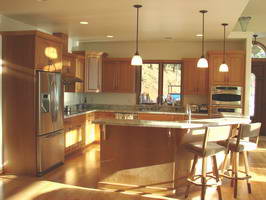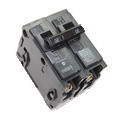How I Install Circuit Breakers in Electrical Service Panels
 '; ';
|
How to Install Circuit Breakers: Organizing the Circuit Cables and Wiring, Making up the Grounds and Neutral Wires, Installing the circuit breakers. © By: Dave Rongey |
Installing Circuit Breakers in an Electrical Panel
Electrical Question: Once all the rough Romex is installed to the residential main 200Amp panel what is the proper way to wire into the panel.
In other words, are the breakers grouped in order of rooms, by breaker size with the larger breakers nearer to the main breaker. Is balancing still a good idea with modern panels like the Cutler Hammer CH 200Amp panel.
This electrical wiring question came from: Greg, a Contractor from Port Angeles, Washington.
Additional Comments: Just found this site a few minutes ago and I am just beginning to explore it. So far, this is one of the most comprehensive sites I’ve seen.
Dave’s Reply:
Thanks for your electrical wiring question Greg.
Procedure for Installing Circuit Breakers in a Panel
Preparation
- Application: Installing or Replacing a 120 Volt or 240 Volt Circuit Breaker.
- Skill Level: Advanced – Best installed by a Licensed Electrician.
- Tools Required: Electricians pouch of hand tools, voltage tester and protective safety gear.
- Estimated Time: Depends on the make and model of the panel and the condition of the existing electrical circuit breakers and wiring methods.
- Precaution: For safety the main circuit breaker should be turned off or any other disconnect means that would de-energize the panel before replacing a circuit breaker, however turning off the main circuit breaker may not de-energize all of the areas of the panel components and wiring. This is an extensive project that requires experience and should be performed by a Licensed Electrical Contractor.
- Notice: Making changes to electrical panel or electric circuits should be done according to local and national electrical codes with a permit and be inspected.
- Organizing the Circuit Cables and Wiring
- When possible, it is a good idea to bring the circuit cables into the electrical panel on the side where the circuit breakers will be installed. Grouping circuit breakers together in a logical order for rooms and equipment will help the homeowner locate the breakers. Clearly label the circuits with a legible marker or tag onto the circuit wires, and on the cover that is installed over the circuit breakers.
- Making up the Grounds and Neutral Wires
Remove the outer sheath covering of the circuit cables leaving at least an inch where the cable enters the panel.
Use about three inches of the uncut sheath to identify the circuit, and then slide the sheath back onto the power conductor wire that will be attached to the circuit breaker. Group all of the ground wires of each circuit together and route them toward the grounding terminal strip.
For a neat job, measure and trim each ground and attach it to the ground terminal strip. Group all of the neutral wires of each circuit together and route them toward the neutral terminal strip. As with the ground wires, measure and trim each ground and attach it to the neutral terminal strip.
Keep in mind that the ground and neutral terminal strips are bonded together at the main panel only, however they are separated in sub-panels. If possible, it is a good idea to attach the ground and neutral wire close to where the circuit breaker will be installed.NOTE: When installing AFCI and GFCI circuit breakers the neutral wire of each circuit must be attached to the AFCI and GFCI circuit breakers, as specified by the circuit breaker manufacturer.
- How to Install Circuit Breakers
The method I use when installing circuit breakers into an electric service panel of a new home is to group the areas of the home together logically so that it will make sense to the homeowner.
For the larger 240 volt circuits I usually place them all together in one general location, usually towards the bottom of the panel if the buss is copper, however I try not to place the larger amperage circuit breakers end to end to avoid the possibility of creating a warm spot on the buss. Load balancing should be done when ever possible to make sure the mains and the neutral are evenly loaded.
Load balancing will make the service more efficient and will have an effect on the electrical usage and billing.IMPORTANT: Be aware of the dangers of electric shock and arc flash hazards associated with working in electrical panels. I do not recommend homeowners to perform any work in electrical panels but rather hire a certified electrician or electrical contractor do perform the electrical wiring for you.
More about Circuit Breakers and Service Panels
House Wiring Circuits and Circuit Breakers
This article looks at common 120 volt and 240 volt house wiring circuits and the circuit breakers that are installed identifying the types and amperage sizes used in most homes.
Circuit breaker
Over Current Protection Provided by Circuit Breakers
A guide to home electrical circuit breakers and how they work to protect your electrical wiring. When properly installed, your home electrical wiring is protected by a circuit protection device.
Electric Circuit Listing
The size of the home electrical service panel is designed by calculating the square footage of the home and factoring in the code requirements for the electrical circuits that are required.
Electrical wire
Electrical Wire for the Home
Complete listing of electrical wire types and parts used for home projects with electrical code information serves as selection guidelines.
The following may also be helpful for you:
|
|
Be Careful and Be Safe - Never Work on Energized Circuits!
Consult your Local Building Department about Permits and Inspections for all Electric Wiring Projects.
More articles about Circuit Breaker, Cutler Hammer Circuit Breaker and Home Electrical Wiring: |
|
| « Previous | Next » |
Making the Right Ceiling Fan Wiring Connections |
Electric Circuit Repair after Flood or Water Damage |


















